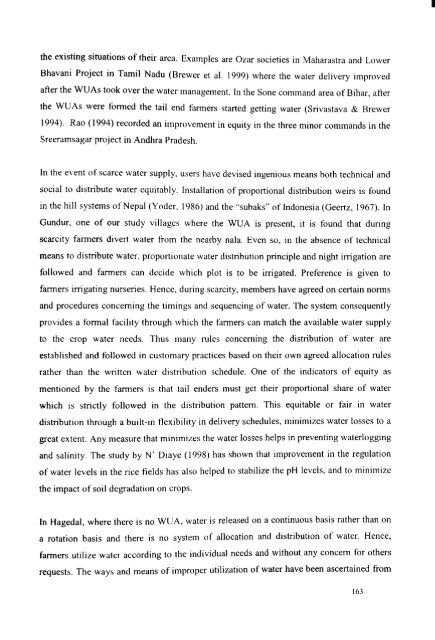Water Users Association and Irrigation Management - Institute for ...
Water Users Association and Irrigation Management - Institute for ...
Water Users Association and Irrigation Management - Institute for ...
Create successful ePaper yourself
Turn your PDF publications into a flip-book with our unique Google optimized e-Paper software.
I<br />
the existing situations of their area. Ex.amples are Ozar societies in Maharastra <strong>and</strong> Lower<br />
Bhavani Project in Tamil Nadu (Brewer et al. 1999) where the water delivery improved<br />
after the WUAs took over the water management. In the Sone comm<strong>and</strong> area of Bihar, after<br />
the WUAs were <strong>for</strong>med the tail end farmers started getting water (Srivastava & Brewer<br />
1994). Rao (1994) recorded an improvcment in equity in the three minor comm<strong>and</strong>s in the<br />
Sreeramsagar project in Andhra Pradesh.<br />
In the event of scarce water supply, users have devised ingenious means both technical <strong>and</strong><br />
social to distribute water equitably. Installation of proportional distribution weirs is found<br />
in the hill systems of Nepal (Yoder. 1986) <strong>and</strong> the "subaks" of Indonesia (Geertz, 1967). In<br />
Gundur, one of our study villagcs where the WUA is present, it is found that dunng<br />
scarcity farmers divert water from the nearby nala. Even so, in the absence of technical<br />
means to distribute water. proportionate water distribution principle <strong>and</strong> night irrigation are<br />
followed <strong>and</strong> farmers can dccide which plot is to be irrigated. Preference is given to<br />
farmers irrigating nurseries. Hence, during scarcity, members have agreed on certain norms<br />
<strong>and</strong> procedures concerning the timings <strong>and</strong> sequencing of water. The system consequently<br />
provides a <strong>for</strong>mal facility through which the farmers can match the available water supply<br />
to the crop water needs. Thus many rules concerning the distribution of water are<br />
established <strong>and</strong> followed in customary practices based on their own agreed allocation rules<br />
rather than the writtcn water distribution schedule. One of the indicators of equity as<br />
mentioned by the farmers is that tail enders must get their proportional share of water<br />
which is strictly followed in the distribution pattern. This equitable or fair in water<br />
distribution through a built-in flexibility in delivery schedules, minimizes water losses to a<br />
great extent. Any measure that minimizes the water losses helps in preventing waterlogging<br />
<strong>and</strong> salinity. The study by N' Diaye (1998) has shown that improvement in the regulation<br />
of water levels in the rice fields has also helped to stabilize the pH levels, <strong>and</strong> to minimize<br />
the impact of soil dq,'Tadation on crops.<br />
In Hagedal, where there is no WUA, water is released on a continuous basis rather than on<br />
a rotation basis <strong>and</strong> there is no system of allocation <strong>and</strong> distribution of water. Hence,<br />
farmers utilize water according to the individual needs <strong>and</strong> without any concern <strong>for</strong> others<br />
requests. The ways <strong>and</strong> means of improper utilization of water have been ascertained from<br />
163
















